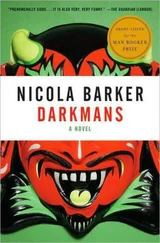Of course, this was not the first occasion on which Uncle had dressed as a woman. Often in the past his female companions had dressed him up in sari s and ornaments — Uncle was their joy, their plaything — so that he might better act the part, and sing the delightful songs, of Radharani or Vrinda. In fact, Uncle loved nothing more than to get dressed up and masquerade as a village woman walking to the tank to fetch water with a pitcher. His observation of all the special female habits and mannerisms was very close. He was utterly convincing as a woman in every way. To the closed-off Western mind Uncle’s pranks may appear shocking, but in these parts we think of such behavior merely as Uncle’s lila —his special play. We see in it a kind of innocent devotion, an expression of the madhura bhava , a sweet mood. There is no deceit in it. Play cannot be deceitful. Nor devotional love. Like Uncle himself, it is simply joyous. It is completely harmless. It is utterly blissful.
America, the late 1950s/early 1960s (an anonymous transgender man speaks)
“I remember being alone on a farm with access to my landlady’s wardrobe … wearing the pretty, old-fashioned dresses made me feel so happy … but after a couple of hours in them I was overcome with sadness and frustration. I wanted to be a woman so badly … but I saw no way to achieve my goal.
“I started to shout at the top of my lungs, ‘I am a woman! I am a woman!’ No one could hear me in the sprawling countryside but the cows and trees and sky.… Then all at once I was flooded with the sweetest, most glorious feeling I have ever had. It seemed to pour out of my heart into my whole body … pure joy just kept bubbling up within me, without any effort on my part. I felt that this feeling was the presence of God. And I decided that it was a sign that God’s grace was most available to me as a woman.”
1836. In the following scene we find the Rani cheerfully contemplating the wider sociopolitical ramifications of her husband’s tragic early death.
Ha! No we don’t. Of course we don’t. The Rani (although she is no rani , no queen; this is merely a fond nickname her mother applied to her which then stuck like ornate sugarwork to the end of a wooden spatula) lives within the asphyxiating vise of the present moment. Clever as she is, hallowed as she is, she still can’t step outside of it. The awesome “power of the present” treads rudely on the back of the skirts of her sari .
But we can. We can step outside of 1836. We can stretch the melted sugar of the Rani’s life and analyze it from a distance. (Although ornate decorative sugarwork is a Western weakness. Let’s replace it with an Indian sweet— burfi , a popular Bengali treat made of sugar and condensed milk. Let’s push our clean thumbs and index fingers into the metal tray containing this sticky, cooling mixture — possibly flavored with coconut or almond or pistachio — pinch it lightly, and then pull the glorious, glutinous mess closer toward us.)
The Rani hails from the lowly Sudra , or servant, caste. Her immensely wealthy husband has just suddenly died from “apoplexy” (which in modern parlance is a hemorrhage or a stroke) during a carriage ride. He is forty-nine years old. Reports tell us that when Rajchandra died the Rani lay groaning on the floor, stricken, for three full days without any food or drink. Then the formal grieving process began: She weighed herself and gave this exact amount to the Brahmin s (the spiritual caste) in silver coins (6,017 of them, in total); she distributed food and gifts to the poor.
It may legitimately cross our minds whether the Rani considered — even briefly — the tradition of sati , and what the implications might have been for her if this practice had not been summarily outlawed by India’s British colonial rulers in 1829 (seven years before). Research tells us that sati was considered to be the ultimate act of honor and devotion by a pious wife (a sign of both insurmountable grief and spiritual renunciation). The Goddess Sati, also known as Dakshayani, was the first incarnation of the Goddess Parvati (who is also called Durga and, ah, Kali). She burned herself alive after her father, Daksha, publicly humiliated her beloved husband, Shiva.
In sati (first celebrated among the Kshatriya , or warrior, caste, and later cautiously embraced throughout Indian society — although notably disapproved of by the Brahmin s) we see a fascinating crossover (a meeting of minds) between the spiritual and the pugnaciously pragmatic. Many Indian faith traditions venerate acts of voluntary self-negation and renunciation above all others (especially for women; these impulses — to negate the self and sacrifice for family — are the natural duties of a good wife and mother, after all). But we also see the widow as a social inconvenience. The widow inherits property, but may only ever be perceived as a temporary custodian of it, since all money and goods are passed on to the husband’s family upon her death. And good widows were — and still are — expected to live only half a life (an excuse for a life, a groveling apology), the life of an ascetic, wearing only white, eating plain food, rejecting all social activities, and sleeping on the ground on a thin grass mat.
Sati , on the other hand, was a helpful foreshortening of this social and emotional purgatory. It was a key to salvation. Its power was vested in the belief that when a widow submits her living body as a burned offering on her husband’s funeral pyre (although many were drowned or buried alive) she gets not only to purge herself of all her sins, but to save her husband’s soul, her own, and those of the following seven generations from the tortuous cycle of rebirth and death. Suicide is forbidden among Hindus, but sati is not suicide, it is a cruel and clever semantic sidestepping of the rules; it is an act of exquisite piety. And when a widow kills herself, her husband’s family — the main players in a story in which the widow is merely a bump in the road, a narrative impediment — may inherit sooner.
What is the Rani thinking as she stands and watches the priests take a lighted tinder to her much-adored Rajchandra’s funeral pyre? She is a modest woman, and pious, and loving, but she is fiercely intelligent. Is there a measure of social pressure? Statistics tell us that the practice of sati was much favored in Bengal during the early part of the Rani’s lifetime. The practice was especially keenly followed in the areas surrounding Calcutta — Kali-cutta; Kali who was Sati who was Dakshayani had immolated herself voluntarily. But the Rani (not a Rani, but our Rani) does not offer herself. Imagine the eyes of the crowd upon her. What are they thinking? Do they judge her?
The writer Lata Mani (in her book Contentious Traditions ) calls that 1829 law “a founding moment in the history of women in modern India.” And the necessary consequences of this “founding moment”? “Women became the site on which tradition was debated.”
This is a debate still raging today.
So our Rani, who is not a queen but of low caste, must now negotiate (in 1836, for heaven’s sake) a complex path between conformity and independence, piety and survival, tradition and modernity, happiness and disapproval. This is a tortuous route. But the Rani will walk it. And she will walk it bravely and lightly. And as she walks it she will throw out sparks of hope to women everywhere. Women then and women now. She will become emblematic of something intangible. Of female power, a power which may only exist — and does and will exist — if it remains charming, superficially submissive, unerringly polite, and appropriately dressed. See the Rani’s flitting eyes? Her sharp mind works feverishly behind her veil.
Читать дальше












